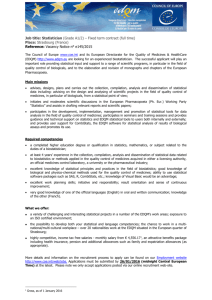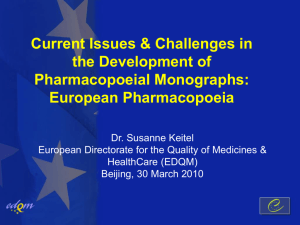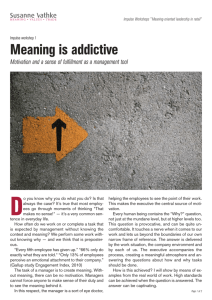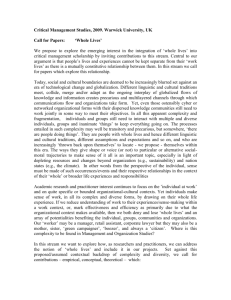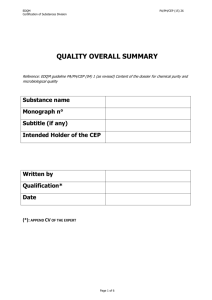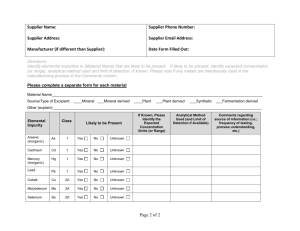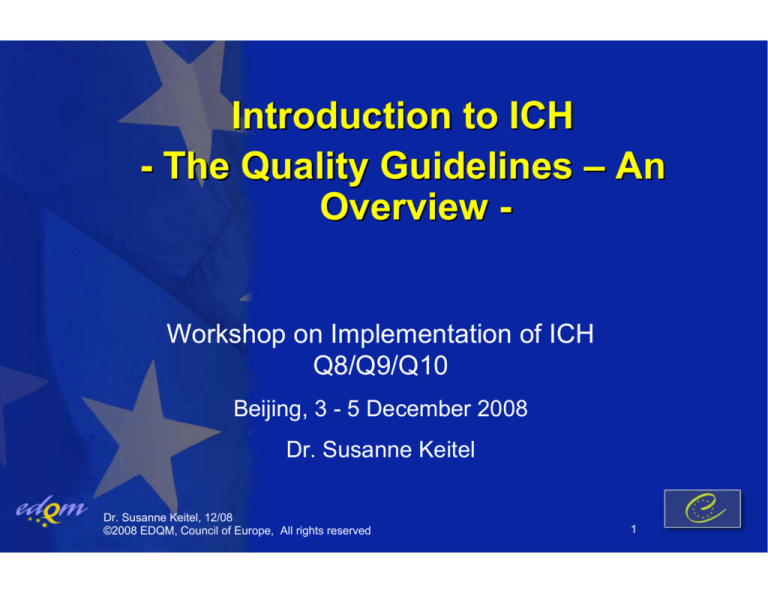
Introduction to ICH
- The Quality Guidelines – An
Overview -
Workshop on Implementation of ICH
Q8/Q9/Q10
Beijing, 3 - 5 December 2008
Dr. Susanne Keitel
Dr. Susanne Keitel, 12/08
©2008 EDQM, Council of Europe, All rights reserved
1
The “Q-Family”
Q 1 – Stability Testing
Q 2 – Analytical Validation
Q 3 – Impurities
Q 4 – Pharmacopoeias
Q 5 – Biotechnological Products
Q 6 – Specifications
Q 7 – Good Manufacturing Practices
Q 8 – Pharmaceutical Development
Q 9 – Quality Risk Management
Q 10 – Pharmaceutical Quality System
Dr. Susanne Keitel, 12/08
©2008 EDQM, Council of Europe, All rights reserved
2
ICH Q 1 – Stability Testing
A set of originally five guidelines (Q1A to Q1F)
defining
- General aspects of stability testing (storage
conditions, batch size and number, length of
time...)
- Photostability
- Application to new dosage forms
- Possibilities for reduced test designs
(bracketing and matrixing)
Dr. Susanne Keitel, 12/08
©2008 EDQM, Council of Europe, All rights reserved
3
ICH Q 1 – Stability Testing
- Statistical evaluation of stability data
and possibilities for extrapolation
- Storage conditions for stability testing in
climatic zones III and IV (withdrawn)
Dr. Susanne Keitel, 12/08
©2008 EDQM, Council of Europe, All rights reserved
4
ICH Q 1 A (R2) – Scope
- For new API and related medicinal products
- To provide evidence on how the quality of an
API/finished product changes with time under
the influence of environmental factors such
as temperature, humidity and light and to
establish a re-test period/shelf-life for the
API/finished product
Dr. Susanne Keitel, 12/08
©2008 EDQM, Council of Europe, All rights reserved
5
ICH Q 1 A (R2) – In a Nutshell...
- Stress testing required for API
- Long-term and accelerated testing required for API and
product, where necessary intermediate testing
- Minimum of three representative batches
- Testing over a minimum of 12 months at LT and 6 months at
accelerated conditions (with defined testing frequency)
- Storage conditions for the “general case”, aqueous products
in semi-permeable containers, products to be stored in a
refrigerator and a freezer
- Stability commitment
Dr. Susanne Keitel, 12/08
©2008 EDQM, Council of Europe, All rights reserved
6
ICH Q 1 B – In a Nutshell...
- Describes requirements on photostability testing and defines
light exposure to be applied
- To be tested on API – if not photosensitive, no further testing
required
- If photosensitive, to be continued on exposed finished
product and product in primary package, product in
marketing package, where relevant
- Where necessary, impact of light during manufacturing
process to be evaluated
- Confirmatory testing required, where applicable
Dr. Susanne Keitel, 12/08
©2008 EDQM, Council of Europe, All rights reserved
7
ICH Q 1 C – In a Nutshell...
- Additional guidance to ICH Q1 A(R2) on new
dosage forms (“line extensions”) for new
substances
- Reduced requirements as regards time to be
covered at LT storage conditions at time of dossier
submissions
Dr. Susanne Keitel, 12/08
©2008 EDQM, Council of Europe, All rights reserved
8
ICH Q 1 D – In a Nutshell...
- Describes possibilities to apply reduced test designs, i.e.
bracketing and matrixing
- Defines situations where reduced testing can be applied
without additional justification, with justification or where it is
not applicable
- Bracketing: testing of extremes only
- Matrixing: testing of a different samples of factor
combinations at different time points during the study
- Provides example designs
Dr. Susanne Keitel, 12/08
©2008 EDQM, Council of Europe, All rights reserved
9
Example of Bracketing Design
Bracketing on strength and container size
Strength
50 mg
Batch
1
2
3
T
T
Container
100 ml
size
500 ml T
T
15 ml
Dr. Susanne Keitel, 12/08
©2008 EDQM, Council of Europe, All rights reserved
75 mg
1
2
100 mg
3
1
2
3
T
T
T
T
T
T
T
T
10
Example of Matrixing Design
Two strengths, matrixing on time point
Time point (months)
S
t
r
e
n
g
t
h
S1
S2
0
3
6
Batch 1
T
T
Batch 2
T
T
Batch 3
T
T
Batch 1
T
T
Batch 2
T
T
Batch 3
T
T
9
12
T
T
T
T
18
24
36
T
T
T
T
T
(T)
T
T
T
T
(T)
T
T
T
T
T
T
T
T
T
T
T
T: Sample tested; (T): Sample tested if full shelf life data will not be
available before approval.
Dr. Susanne Keitel, 12/08
©2008 EDQM, Council of Europe, All rights reserved
11
ICH Q 2 – Analytical Validation
A guideline defining the validation
parameters needed for a variety of
analytical methods and describing
characteristics to be considered for the
validation of analytical procedures
included in a marketing authorisation
dossier
Dr. Susanne Keitel, 12/08
©2008 EDQM, Council of Europe, All rights reserved
12
ICH Q 2 – ... In a Nutshell
-
Defines criteria for the validation of the four
most common types of analytical procedures:
identification tests
quantitative tests for impurities
limit tests for the control of impurities
quantitative tests for the active moiety in API
or finished product or or other selected
components in the product
Dr. Susanne Keitel, 12/08
©2008 EDQM, Council of Europe, All rights reserved
13
ICH Q 2 – ... In a Nutshell
Defines typical analytical validation
characteristics, to which tests to apply them
and examples on the “how to”
- Accuracy
- Precision
- Repeatability
- Intermediate Precision
-
Specificity
Detection Limit
Quantitation Limit
Range
Dr. Susanne Keitel, 12/08
©2008 EDQM, Council of Europe, All rights reserved
14
Typical Validation Characteristics
Validation
Characteristics
Identification
Testing for Impurities
quantitative
limit
Assay
Accuracy
-
+
-
+
Precision
Repeatability
Int. Precision
-
+
+
-
+
+
Specificty
+
+
+
+
Detection Limit
-
-
+
-
Quant. Limit.
-
+
-
-
Linearity
-
+
-
+
Range
-
+
-
+
Dr. Susanne Keitel, 12/08
©2008 EDQM, Council of Europe, All rights reserved
15
ICH Q 3 – Impurities
A set of three guidelines addressing the
chemistry and safety aspects of impurities,
including the listing of impurities in
specifications. Defines the thresholds for
reporting, identification and qualification of
impurities in API and finished product.
Specific guideline on residual solvents
Dr. Susanne Keitel, 12/08
©2008 EDQM, Council of Europe, All rights reserved
16
ICH Q 3 A(R) – in a Nutshell
Classifies impurities
- organic impurities
•
•
•
•
•
Starting materials
By-products
Inermediates
Degradation products
Reagents, ligants, catalysts
- Inorganic impurities
•
•
•
•
Reagents, liegands, catalysts
Heavy metals or other residual metals
Inorganic salts
Other impurities, e.g. filter aids, charcoal…
- Residual solvents
Dr. Susanne Keitel, 12/08
©2008 EDQM, Council of Europe, All rights reserved
17
ICH Q 3 A(R) – in a Nutshell
Defines rationale for the reporting and control of
impurities as well as requirements for listing
impurities in specifications:
Organic Impurities
- Each specified identified impurity
- Each specified unidentified impurity
- Any unspecified impurity with acceptance criterion of NMT the
identification threshold
Residual solvents
Inorganic impurities
Dr. Susanne Keitel, 12/08
©2008 EDQM, Council of Europe, All rights reserved
18
ICH Q 3 A(R) – in a Nutshell
Definitions
Identified impurity:
…. impurity for which a structural characterisation
has been achieved
Qualification:
….is the process of acquiring and evaluating data
that establishes the biological safety of an individual
impurity or a given impurity profile at the level(s)
specified.
Dr. Susanne Keitel, 12/08
©2008 EDQM, Council of Europe, All rights reserved
19
ICH Q 3 A(R) – in a Nutshell
Definitions
Specified impurity:
… impurity that is individually listed and limited with a
specific acceptance criterion in the specification. Can be
either identified or unidentified.
Unidentified impurity:
… impurity for which a structural characterisation has not
been achieved and that is solely defined by qualitative
analytical properties, e.g. chromatographic retention time
Unspecified impurity:
… impurity that is limited by a general acceptance criterion,
but not individually listed with its own specific acceptance
criterion in the specification
Dr. Susanne Keitel, 12/08
©2008 EDQM, Council of Europe, All rights reserved
20
Thresholds for Impurities in API
Maximum
Daily Dose
Reporting
Threshold
≤ 2 g/day
0.05 %
> 2 g/day
0.03 %
Identification
Threshold
0.10 % or 1.0 mg/day
(whichever is lower)
Qualification
Threshold
0.15 % or 1.0mg/day
(whichever is lower)
0.05 %
0.05 %
♦ number of decimal digits: two below 1.0 %, one above 1.0 %
♦ application of conventional rounding rules
♦ total impurities > reporting threshold
Dr. Susanne Keitel, 12/08
©2008 EDQM, Council of Europe, All rights reserved
21
Thresholds of Impurities in Finished Products
Example 15 mg/day
Reporting threshold
0.1 %
Identification threshold 0.5%/20 µg TDI
Qualifcation threshold
Dr. Susanne Keitel, 12/08
©2008 EDQM, Council of Europe, All rights reserved
0.5%/200µg TDI
22
ICH Q 3 C – in a Nutshell
Recommends acceptable amounts for
residual solvents in pharmaceuticals for the
safety of patients, recommends use of less
toxic solvents and describes levels
considered to be toxicologically acceptable
for some solvents. Non-exhaustive list of
solvents included in the guideline as annex.
Dr. Susanne Keitel, 12/08
©2008 EDQM, Council of Europe, All rights reserved
23
Classification of Residual Solvents
Class I
⇒ solvents to be avoided
Class II
Known human carcinogens, strongly
suspected human carcinogens, and
environmental hazards
Non-genotoxic animal carcinogens or possible
causative agents of other irreversible toxicity.
Solvents suspected of other significant but
reversible toxicities
⇒ solvents to be limited
Solvents with low toxic potential to man;
no health-based exposure limit is needed
Class III
⇒ solvents with low toxic potential
Dr. Susanne Keitel, 12/08
©2008 EDQM, Council of Europe, All rights reserved
24
Classification of Residual Solvents
Benzene, carbon tetrachloride,
Class I
⇒ solvents to be avoided
Class II
1,2-dichloroethane, 1,1-dichloroethene, 1,1,1trichloroethane
Acetonitrile, chloroform, cyclohexane,
dioxane, methanol, methylbutylketone,
tetrahydrofurane, toluene, ...
⇒ solvents to be limited
Class III
Acetone, butanol, butyl acetate, DMSO, ethanol,
ethyl acetate, ethyl ether, heptane, isopropanol,
methylethyl ketone, ...
⇒ solvents with low toxic potential
Dr. Susanne Keitel, 12/08
©2008 EDQM, Council of Europe, All rights reserved
25
ICH Q3 C – in a Nutshell
Defines options for the definition of acceptance criteria
for class 2 solvents
Option 1
⇒ tabulated limits,
calculated on the basis of a TDI of 10 g of the product
Option 2
⇒ not all individual components of a product have to comply
with the tabulated limits – the total content of the solvent
has to be below the permitted daily intake (PDE)
Dr. Susanne Keitel, 12/08
©2008 EDQM, Council of Europe, All rights reserved
26
ICH Q3 C – in a Nutshell
Example for option 2
Concentration = 1000 x PDE
Dose
Component
Amount in
Formulation
Content
Acetonitril *
Daily Intake
API
0.3 g
800 ppm
0.24 mg
Excipient 1
0.9 g
400 ppm
0.36 mg
Excipient2
3.8 g
800 ppm
3.04 mg
Product
5.0 g
728 ppm
3.64 mg
9
* PDE: 4.1 mg/day, limit: 410 ppm
Dr. Susanne Keitel, 12/08
©2008 EDQM, Council of Europe, All rights reserved
27
ICH Q 4 – Pharmacopoeias
Harmonisation of 10 general methods
referred to in the ICH specification guideline
ICH Q 6A is undertaken by the
Pharmacopoeial Discussion Group (PDG).
ICH Q4 B evaluates selected pharmacopoeial
texts to facilitate their recognition by
regulatory authorities as interchangeable in
the ICH region. Adopts specific annexes for
the different texts.
Dr. Susanne Keitel, 12/08
©2008 EDQM, Council of Europe, All rights reserved
28
ICH Q 5 – Biotechnological
Products
A set of five guidelines defining requirements
on various specifics for biotechnological
products:
- viral safety
- Analysis of the expression construct in cells
used for production of r-DNA derived protein
products
- Stability testing
Dr. Susanne Keitel, 12/08
©2008 EDQM, Council of Europe, All rights reserved
29
ICH Q 5 – Biotechnological
Products
- Derivation and characterisation of cell
substrates
- Comparability of
biotechnological/biological products
subject to changes in the manufacturing
process
Dr. Susanne Keitel, 12/08
©2008 EDQM, Council of Europe, All rights reserved
30
ICH Q 6 – Specifications
Two guidelines addressing the selection
of tests and methods and setting
specifications for quality control of API
and finished products (chemicals and
biotechnologically derived proteins and
polypeptides)
Dr. Susanne Keitel, 12/08
©2008 EDQM, Council of Europe, All rights reserved
31
ICH Q 6A – ... In a Nutshell
Intended to assist in the establishment
of a single set of global specifications for
API and finished product. Provides
guidance on the setting and justification
of acceptance criteria and the selection
of test procedures.
Dr. Susanne Keitel, 12/08
©2008 EDQM, Council of Europe, All rights reserved
32
ICH Q 6A – ... In a Nutshell
Specification:
…. A list of tests, references to analytical
procedures and appropriate acceptance
criteria, which are numerical limits, ranges or
other criteria for the tests described.
Establishes the set of criteria to be met in
order to be considered “acceptable for
intended use”.
… “Conformance to specification” means that
the API/product will meet the acceptance
criteria WHEN tested
Dr. Susanne Keitel, 12/08
©2008 EDQM, Council of Europe, All rights reserved
33
ICH Q 6A – ... In a Nutshell
Specifications (cont.):
…. Are proposed/justified by applicant and approved
by regulatory authorities as conditions of approval
…. Are one part of a total control strategy for the
API/product. Other parts or this strategy include
thorough product characterisation during
development and adherence to GMP (!!)
… are chosen to confirm the quality… rather than to
establish full characterisation, should focus on
those characteristics useful in ensuring the safety
and efficacy of the product.
Dr. Susanne Keitel, 12/08
©2008 EDQM, Council of Europe, All rights reserved
34
ICH Q 6A – ... In a Nutshell
Defines general concepts, e.g.
-
Periodic or skip testing
Release vs. shelf-life acceptance criteria
In-process tests
Design and development considerations
Limited data available at filing
Parametric release
Alternative procedures
Pharmacopoeial tests and acceptance criteria
Evolving technologies
Impact of API on product specifications
Reference standard
Dr. Susanne Keitel, 12/08
©2008 EDQM, Council of Europe, All rights reserved
35
ICH Q 6A – ... in a Nutshell
Defines universal tests/criteria for
- API
- Finished product
Defines additional specific tests/criteria for
- API
- Finished product
¾ Solid oral dosage forms
¾ Oral liquids
¾ Parenteral drug products
Dr. Susanne Keitel, 12/08
©2008 EDQM, Council of Europe, All rights reserved
36
Universal Tests/Criteria - API
Description
Identification
⇒ specific for the substance (e.g.: IR, HPLC/UV (DAD),
HPLC/MS, GC/MS)
Assay
⇒ specific / stability indicating procedure
often possible to use method that is also used for
quantification of impurities (e.g. HPLC
Impurities (organic, inorganic, residual solvents)
⇒ specific /stability-indicating procedure
⇒ Decision tree # 1 on extrapolation of meaningful limits
Dr. Susanne Keitel, 12/08
©2008 EDQM, Council of Europe, All rights reserved
37
Universal Tests/Criteria - Product
Description
Identification
⇒ specific (IR, HPLC/UV (DAD),
HPLC/MS, GC/MS)
Assay
⇒ specific / stability-indicating procedure
(z.B. HPLC, which is also used for impurities quantification,
where applicable, results of content uniformity test can be used)
Impurities (organic, inorganic, residual solvents)
⇒ specific /stability-indicating procedure: degradation products and
impurities arising during the manufacturing process
⇒ Decision tree #2 on extrapolation of meaningful limits
Dr. Susanne Keitel, 12/08
©2008 EDQM, Council of Europe, All rights reserved
38
Examples of Specific Tests/Criteria - API
Physicochemical properties
⇒ pH, melting point/range, refractive index ...
Particle size
⇒ API in solid or suspension drug products
Decision tree #3
Polymorphic forms
⇒ crystalline forms. Solvates, hydrates
thermal analysis (DSC, DTA), IR, microscopy, X-ray
powderrdiffraction, ... For the finished product normally dissolution
as surrogate parameter
⇒ Decision tree #4(1)-4(3)
Dr. Susanne Keitel, 12/08
©2008 EDQM, Council of Europe, All rights reserved
39
Examples of Specific Tests/Criteria – Solid Oral
Dosage Forms
Dissolution
⇒ in-vitro-release of active from the product.
single point-measurement for immediate release products
multiple time point sampling for extended release, two-stage testing
for delayed release dosage forms
⇒Decision tree # 7 (1-3)
Disintegration
⇒ may be substituted for dissolution for rapidly dissolving prodcuts
containing active which is highly soluble throughout the physiological
range
Dr. Susanne Keitel, 12/08
©2008 EDQM, Council of Europe, All rights reserved
40
ICH Q 7 – GMP for API
A guideline defining GMP requirements
for the manufacture of API – based on
existing regional and international
(PIC/S) guidance, elaborated jointly with
representatives from the generic and
self-medication industry, PIC/S,
Australia, India and China
Dr. Susanne Keitel, 12/08
©2008 EDQM, Council of Europe, All rights reserved
41
ICH Q 7 - .... In a Nutshell
-
Introduction
Quality Management
Personnel
Buildings and Facilities
Process Equipment
Documentation and Records
Materials Management
Production and In-Process Controls
Dr. Susanne Keitel, 12/08
©2008 EDQM, Council of Europe, All rights reserved
42
ICH Q 7 - .... In a Nutshell
- Packaging and Identification / Labelling of
APIs and Intermediates
- Storage and Distribution
- Laboratory Controls
- Validation
- Change Control
- Rejection and Re-Use of Material
- Complaints and Recalls
Dr. Susanne Keitel, 12/08
©2008 EDQM, Council of Europe, All rights reserved
43
ICH Q 7 - .... In a Nutshell
- Agents, Brokers, Traders, Distributors,
Repackers and Relabellers
- Specific Guidance for APIs
manufactured by Cell
Culture/Fermentation
- APIs for Clinical Trials
- Glossary
Dr. Susanne Keitel, 12/08
©2008 EDQM, Council of Europe, All rights reserved
44
ICH M4 Q – Commont
Technical Document
… defines a common format for the
marketing authorisation application in the ICH
region, BUT addresses only format/structure,
not the specific requirements
CTD merely indicates the location where
information has to be provided
Dr. Susanne Keitel, 12/08
©2008 EDQM, Council of Europe, All rights reserved
45
Submission of the Dossier
Structure of
the Common
Technical
Document
(CTD)
Dr. Susanne Keitel, 12/08
©2008 EDQM, Council of Europe, All rights reserved
46
Module 2: Overviews and
summaries
2.1
2.2
2.3
2.4
2.5
2.6
2.7
CTD TOC Modules 2-5
Introduction
Quality Overall Summary
Nonclinical Overview
Clinical Overview
Nonclinical Summary
Clinical Summary
Dr. Susanne Keitel, 12/08
©2008 EDQM, Council of Europe, All rights reserved
47
Module 3: Quality
General Structure/Drug Substance
3.2 S
3.2 S1
3.2 S2
3.2 S3
3.2 S4
3.2 S5
3.2 S6
3.2 S7
Drug Substance
General Information
Manufacture
Characterisation
Control of Drug Substance
Reference Standards or Materials
Container Closure System
Stability
Dr. Susanne Keitel, 12/08
©2008 EDQM, Council of Europe, All rights reserved
48
General Structure/Drug Product
3.2 P
3.2 P1
3.2 P2
3.2 P3
3.2 P4
3.2 P5
3.2 P6
3.2 P7
3.2 P8
Drug Product
Description and Composition of the Drug
Product
Pharmaceutical Development
Manufacture
Control of Excipients
Control of Drug Product
Reference Standards or Materials
Container Closure System
Stability
Dr. Susanne Keitel, 12/08
©2008 EDQM, Council of Europe, All rights reserved
49
General Structure/Appendices etc.
A
Appendices
A1 Facilities and Equipment
A2 Adventitous Agents Safety Evaluation
R
Regional Information
C
Key Literature References
Dr. Susanne Keitel, 12/08
©2008 EDQM, Council of Europe, All rights reserved
50
Thank you!

